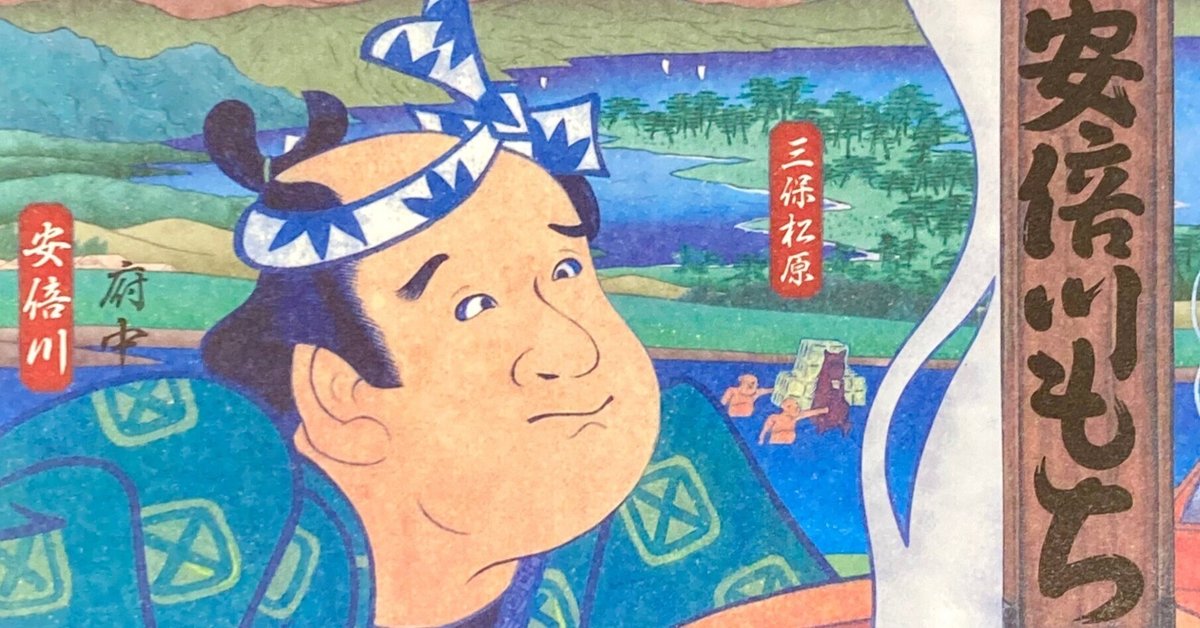
Dig Japan vol.22 “Abekawamochi (安倍川もち)”
Abekawamochi is wagashi that is a specialty of Shizuoka City, Shizuoka Prefecture, and is said to have been named by Tokugawa Ieyasu. Originally it was served with kinako (soybean flour) and white sugar, but nowadays it is common to have two types of mochi, one with kinako and one with anko (bean paste), on one plate.

First, let's unravel the origins of the name Abekawamochi, which is said to have been coined by Tokugawa Ieyasu. During the Keicho era (1596-1615), when Ieyasu had Sunpu Castle, gold mining was thriving in the Ikawa area upstream of the Abe River. One day, when Ieyasu was visiting the area to inspect it, a man pounded mochi, sprinkled it with soybean flour, and presented it to Ieyasu.
It was so delicious that Ieyasu asked how it was made, and the man cleverly changed the word “kinako” to mean kinko (gold dust), and replied that the mochi was made with kinko scooped up from the Abe River. Ieyasu is said to have praised the man's witness, rewarded him, and named the mochi “Abekawamochi.” Since then, Abekawamochi shops have lined up along the Abe River in Miroku.
Since the early modern period, Abekawamochi has been widely introduced in many travel writings, essays, and paintings, including Jippensha Ikku's “Tokaidochu hizakurige.” Abekawamochi was originally made with kinako, but later anko was also used.
Another feature is that it uses white sugar, which was highly prized during the Tokugawa period. Abekawamochi, sold along the Abe River, was served on a tray with two types of mochi, kinako and anko, sprinkled with sugar. In the past, it was also called “Kamikomochi” after “Abekawa kamiko,” a type of paper clothing that was a specialty of the Abe River. It cost 5 mon (Japanese currency at the time) for five pieces, but later came to be sold for 5 mon per piece.

Abekawamochi, a Tokaido specialty that can now be purchased at Japanese sweets shops in Shizuoka City and at JR Shizuoka Station, has long been popular among travelers. Saigo Takamori allegedly ate it while resting at a teahouse when he visited Abekawa around the time of the Meiji Restoration.
In the past, when people from Suruga departed for the western part of Japan, their relatives and acquaintances would see them off in the Miroku area, hold farewell parties at teahouses, and people who liked alcohol would enjoy eating them with wasabi soy sauce. On the east side of the old Tokaido Abekawa Bridge, there are still several teahouse-style shops that make and sell the wasabi soy sauce version.
Meanwhile, in Yamanashi Prefecture and other areas, there is a custom of offering Abekawamochi sprinkled with kinako and kuromitsu syrup to Buddhist altars during the Obon festival, and during this time, local supermarkets and Japanese sweet shops only sell this type. This custom gave birth to a souvenir sweet called “Shingenmochi.”
This article was written by 𝐡𝐢𝐫𝐨𝐤𝐨, working as a freelance translator and press for overseas apparel brands in Japan, with the purpose of broadening her insight into the Japanese traditional culture.
いつも読んでくださってありがとうございます☺︎いただいたサポートは、記事のクオリティ向上に活用させていただきます。応援よろしくお願いします❦
